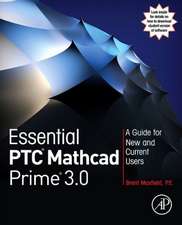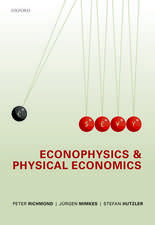Geometric Mechanics and Symmetry: From Finite to Infinite Dimensions: Oxford Texts in Applied and Engineering Mathematics, cartea 12
Autor Darryl D. Holm, Tanya Schmah, Cristina Stoicaen Limba Engleză Paperback – 30 iul 2009
| Toate formatele și edițiile | Preț | Express |
|---|---|---|
| Paperback (1) | 406.55 lei 31-37 zile | |
| OUP OXFORD – 30 iul 2009 | 406.55 lei 31-37 zile | |
| Hardback (1) | 839.44 lei 31-37 zile | |
| OUP OXFORD – 30 iul 2009 | 839.44 lei 31-37 zile |
Preț: 406.55 lei
Preț vechi: 458.23 lei
-11% Nou
Puncte Express: 610
Preț estimativ în valută:
77.79€ • 81.44$ • 64.37£
77.79€ • 81.44$ • 64.37£
Carte tipărită la comandă
Livrare economică 25-31 martie
Preluare comenzi: 021 569.72.76
Specificații
ISBN-13: 9780199212910
ISBN-10: 0199212910
Pagini: 526
Ilustrații: 32 line illustrations and 4 halftones
Dimensiuni: 155 x 233 x 30 mm
Greutate: 0.79 kg
Editura: OUP OXFORD
Colecția OUP Oxford
Seria Oxford Texts in Applied and Engineering Mathematics
Locul publicării:Oxford, United Kingdom
ISBN-10: 0199212910
Pagini: 526
Ilustrații: 32 line illustrations and 4 halftones
Dimensiuni: 155 x 233 x 30 mm
Greutate: 0.79 kg
Editura: OUP OXFORD
Colecția OUP Oxford
Seria Oxford Texts in Applied and Engineering Mathematics
Locul publicării:Oxford, United Kingdom
Recenzii
The book provides a very comprehensive presentation of ideas and methods from geometric mechanics, aimed at the graduate-student level, but it could also be of interest for specialists who want to refresh their knowledge in this modern, elegant and unifying formulation of Lagangrian and Hamiltonian mechanics.
...the book makes much more than merely allowing students to pass from one book to the other, and turns out to be a very well written and self-contained treatment of the interplay between mechanics and symmetry.
Throughout the text the exposition is very clear, and this is in big part due to the extensive use of detailed examples, which is probably one of the strongest pedagogical points of this text when compared with other text books with similar subjects and targets...This makes this text the starting point for any researcher interested in getting started in the field of geometric models for continuum systems.
...the book makes much more than merely allowing students to pass from one book to the other, and turns out to be a very well written and self-contained treatment of the interplay between mechanics and symmetry.
Throughout the text the exposition is very clear, and this is in big part due to the extensive use of detailed examples, which is probably one of the strongest pedagogical points of this text when compared with other text books with similar subjects and targets...This makes this text the starting point for any researcher interested in getting started in the field of geometric models for continuum systems.
Notă biografică
Darryl D Holm spent thirty four years at Los Alamos National Laboratory before moving in 2005 to Imperial College London as Professor of Applied Mathematics. During his career, Darryl developed a wide range of applications of the geometric approach to dynamical systems. His main interest is in deriving and analyzing nonlinear evolution equations for multiscale phenomena. Applications of these equations have ranged from nonlinear optical pulses used in telecommunications, to turbulence modeling for global ocean circulation and climate prediction, to template matching for the shapes of biomedical images, to directed self-assembly in nanoscience. The solution behavior of these equations includes solitons (governed by the Camassa-Holm equation), vortices and turbulence (modelled by the LANS-alpha equation) and emergent singularities (modelled by the EPDiff equation) representing the sharp edges that appear in biomedical images.Tanya Schmah completed her PhD in mathematics in 2001 at the Swiss Federal Institute of Technology in Lausanne. She has held lectureships at the University of Warwick (U.K.) and Macquarie University (Australia), and is currently working in the Department of Computer Science at the University of Toronto. She has a wide range of interests in mathematics and computer science, including symmetric Hamiltonian systems and machine learning.Cristina Stoica has a Diploma in Mathematics-Mechanics from the University of Bucharest (1991) and possesses a Doctor of Sciences degree in Astronomy awarded by the Astronomical Institute of the Romanian Academy (1997). She also holds a PhD in Applied Mathematics from the University of Victoria, Canada (2000). Currently she is a faculty member at Wilfrid Laurier University, Canada. Her main interests lie at the intersection of dynamical systems and mathematical physics.























